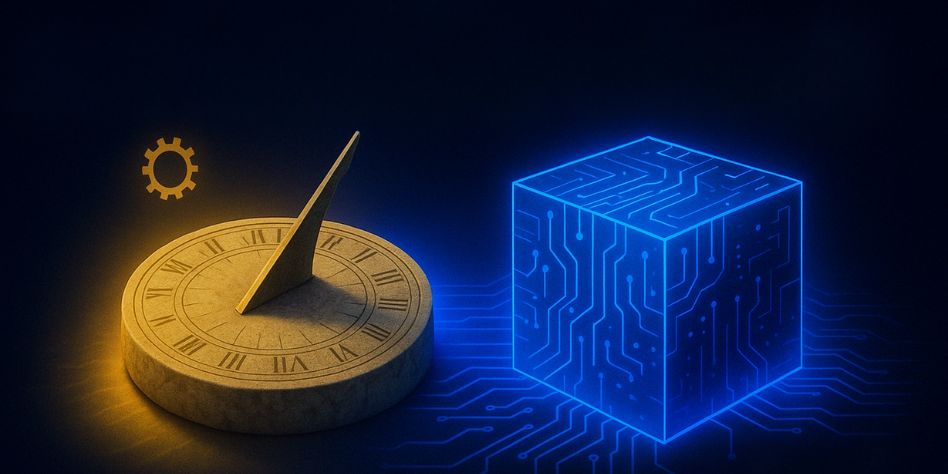Ever checked the time on your phone? What if I told you it all started with a sundial—a simple tool that, centuries later, ignited the supercomputers behind your tech? I’m Chronos Link, your guide at The Burkean Chain, unraveling how a stick in the sand launched a tech revolution. It’s a wild leap from ancient shadows to machines that predict storms and explore stars. Ready to dive into the story?
1500 BCE: Sundial’s First Tick
In ancient Egypt, around 1500 BCE, people lived by the rhythm of the sun. Picture the scorching desert—they were captivated by the sun’s blazing path across the sky! To harness its power, they invented the sundial, a simple yet brilliant tool that used the sun’s shadow to tell time. These early sundials weren’t just timekeepers; they were a step toward mastering precision. They symbolized knowledge and control, letting Egyptians plan their days and track the seasons—a turning point in humanity’s quest to measure time with precision.
240 BCE: Greeks’ Cosmic Clocks
The Greeks got their hands on the Egyptian sundial—and wow, did they run with it! Around 240 BCE, astronomer Eratosthenes and others crafted portable sundials so precise, they could tell time anywhere on Earth. The Greeks were total stargazers, using those sundials to nail down time so perfectly that they could chart the stars’ movements at night. That led to jaw-dropping discoveries—they figured out the Earth was a sphere and measured its circumference, getting scarily close to the real number! The humble sundial had become a tool for unlocking the universe’s secrets, all by sharpening our grasp of precision.
1300: Clocks Sync Society
By 1300, the mechanical clock burst onto the scene—a total game-changer! No more waiting for the sun; this took the sundial’s precision to new heights. Over the centuries, clocks got sharper and fancier—gears ticking with incredible precision! They weren’t just for churches or town squares anymore—they popped up in homes and workplaces. Time got standardized across regions. Suddenly, everyone lived by the clock’s beat: work schedules locked in, daily life sped up, and entire towns synced to the same rhythm. The clock, once a shiny symbol of progress, now called the shots in our lives.
1820s: Babbage’s Computing Dream
Fast-forward to the 1820s—meet Charles Babbage, an English mathematician with a wild vision! Building on the precision of mechanical clocks, he dreamed up the Difference Engine, a gear-driven calculator that tackled complex math like magic. But Babbage didn’t stop there—he designed the bolder Analytical Engine, a general-purpose computer that used punch cards to program any task. Yep, coding was born! His ideas were totally out there, earning him the title ‘father of computing,’ setting the stage for the digital revolution to come.
1940s: Codebreaking to Transistors
In the 20th century, computing exploded onto the scene! During World War II, the need to crack enemy codes—like the Lorenz cipher—gave us Colossus, one of the first digital computers, ditching gears for vacuum tubes to crank up precision and speed. After the war, things moved fast! In 1947, the transistor burst in—a tiny game-changer that was smaller, faster, and way more reliable than tubes, shrinking machines and speeding them up even more. Early computers were massive beasts, only for governments and big corporations. But transistors flipped the script, bringing computing power to businesses and everyday folks.
Today: Supercomputers Solve All!
Fast-forward to today—supercomputers now perform a quintillion calculations a second, pushing precision to the max! They predict your weather, design life-saving drugs, even probe black holes—mind-blowing, right? All tracing back to that sundial’s shadow! They’re also tackling humanity’s biggest challenges, like climate change and disease, unlocking a future of endless possibilities. From sundials to supercomputers, it’s a wild leap of human ingenuity—and it’s right in your pocket daily with your phone’s apps and AI chats. How’s that for a leap?
Join the Chain!
Dig this journey? Share it with a friend who loves tech quirks! Watch our full video on YouTube, where I dive deeper. What’s your guess for the next link—fires to fame? Drop your thoughts on the video, subscribe for Episode 2, and follow @BurkeanChain on X for teasers! #BurkeanChain

